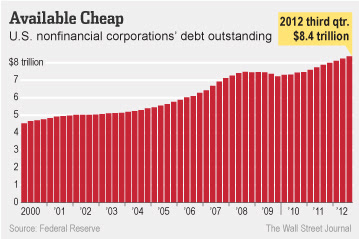Graph of the week: Where's the money?
The Wall Street Journal brings the following story:
"$8.4 trillion: The amount of debt owed by U.S. corporations at the end of September.
When policymakers at the Federal Reserve meet next week, one of their main agenda items will be assessing the effectiveness of their latest bond-buying program, known as “quantitative easing” or QE. A key goal of the program is to stimulate the economy by driving down interest rates, making it cheaper for companies and individuals to borrow. More borrowing, the Fed hopes, will lead to more spending, more investing and, crucially, more hiring."
 |
| Source: WSJ Real Time Economics blog |
One should ask himself, with all this debt pilling up, where is the money ending up? The logical explanation is to pay off former debt thereby paying off the creditors (have in mind that the graph shows nonfinancial corporate debt). Is this how the deleveraging process is supposed to work? Piling up more debt to pay off the former debt? According to this the only true deleveraging took place immediately during the crisis. Everything afterwards, in total, was an increase of corporate debt.
A graph I've shown earlier in October depicts the deleveraging of the US government, household, financial and corporate nonfinancial sectors, and it seems that only the final category (corporate nonfinancials) is not deleveraging at all. The WSJ graph above confirms this troublesome trend.
A graph I've shown earlier in October depicts the deleveraging of the US government, household, financial and corporate nonfinancial sectors, and it seems that only the final category (corporate nonfinancials) is not deleveraging at all. The WSJ graph above confirms this troublesome trend.
This means that Reinhart and Rogoff were right in pointing out that the deleveraging process currently under way has been very sluggish, which is what they recognize as the main obstacle to a faster recovery.
Going back to the initial point made by the WSJ blog, what does this tell us about the effectiveness of Fed's bond buying program? It tells us that large scale bond buying (QE) doesn't seem to show (the expected) positive effects. More borrowing isn't being translated into more investments or more hiring (at least not to the expected extent). Neither are real wages increasing, while business activity experienced a decrease for the first time since 2009 (2.2% in the thrid quarter).
The only place where money could end up is in reserves. Cash reserves to be more specific. A total of $1.74 trillion. So just like banks and their overnight deposits (among other types of reserves), private sector corporations are also pilling up cash (cash hoarding). The reason is simple - uncertainty. The type of uncertainty that cannot and will not be solved by short-run policy measures aiming to affect medium run expectations on easy policy. Throwing more cash at cash-hoarding companies and banks won't incentivise them to spend it. The incentives must come from another angle.
The only place where money could end up is in reserves. Cash reserves to be more specific. A total of $1.74 trillion. So just like banks and their overnight deposits (among other types of reserves), private sector corporations are also pilling up cash (cash hoarding). The reason is simple - uncertainty. The type of uncertainty that cannot and will not be solved by short-run policy measures aiming to affect medium run expectations on easy policy. Throwing more cash at cash-hoarding companies and banks won't incentivise them to spend it. The incentives must come from another angle.




Exactly right.
ReplyDelete